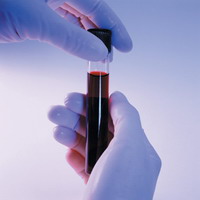Stored blood may lack vital component
Much of the stored blood may lack a component vital for it to deliver oxygen to the tissues.

Nitric oxide, which helps keep blood vessels open, begins breaking down as soon as blood goes into storage, two research teams report in separate studies in this week's online edition of Proceedings of the National Academy of Sciences.
In recent years, doctors have become increasingly concerned about levels of heart attack and stroke in patients receiving transfusions and the new findings may help explain that.
"It doesn't matter how much oxygen is being carried by red blood cells; it cannot get to the tissues that need it without nitric oxide," said Dr. Jonathan Stamler of Duke University, leader of one of the research groups.
Blood vessels relax and constrict to regulate blood flow, and nitric oxide opens up blood vessels to allow red blood cells to deliver oxygen, he explained.
"If the blood vessels cannot open, the red blood cells back up in the vessel and tissues go without oxygen. The result can be a heart attack or even death," he said.
"The issue of transfused blood being potentially harmful to patients is one of the biggest problems facing American medicine," said Stamler.
Several of the researchers, including Stamler, have consulting and/or equity relationships with Nitrox/N30, a company developing nitric oxide-based therapies.
The second research team, led by Dr. Timothy McMahon, also at Duke, studied the changes in stored blood over time. Currently blood is allowed to be kept in blood banks for up to 42 days. After that it must be discarded. An estimated 14 million units of red blood cells are administered to about 4.8 million Americans annually.
"We were surprised at how quickly the blood changes; we saw clear indications of nitric oxide depletion within the first three hours," McMahon said in a statement.
Stamler said in a telephone interview that the researchers knew that nitric oxide is responsible for opening up small blood vessels but previously had not measured the amount of that chemical in stored blood.
"Surprisingly, we found blood depleted profoundly by day one, and it remained depleted through day 42," he said.
But if they restored the nitric oxide at any point, the red blood cells were again able to open blood vessels and deliver oxygen to tissues, they said. They tested the blood with added nitric oxide both in the laboratory and in dogs.
"This is an important observation and it needs to be followed up," said Dr. Louis Katz, a past president of America's Blood Centers, which provides about half the nation's blood.
"If you are going to store red cells, is there a way to make sure appropriate nitric oxide levels are maintained?" said Katz, who was not part of the research teams.
It is possible that these findings may make the public concerned about transfusions, Katz said: "There is no doubt, if you are bleeding to death from a trauma" you need a transfusion.
Stamler agreed that "physicians need to be able to give blood if people are bleeding profusely."
Overall, Katz said: "This is neat research. It needs to be proven that it's clinically relevant."
Yes, Stamler said, more clinical trials are needed.
"Banked blood is truly a national treasure that needs to be protected," Stamler said. "Blood can be lifesaving, only it is not helping the way we had hoped, and in many cases it may be making things worse. In principle, we now have a solution to the nitric oxide problem - we can put it back - but it needs to be proven in a clinical trial."
The research was supported by the National Institutes of Health, Duke Anesthesiology Fund, the American Heart Association and N30 Pharma, which has a license agreement with Duke to develop nitric oxide-based therapies.
Subscribe to Pravda.Ru Telegram channel, Facebook, RSS!





